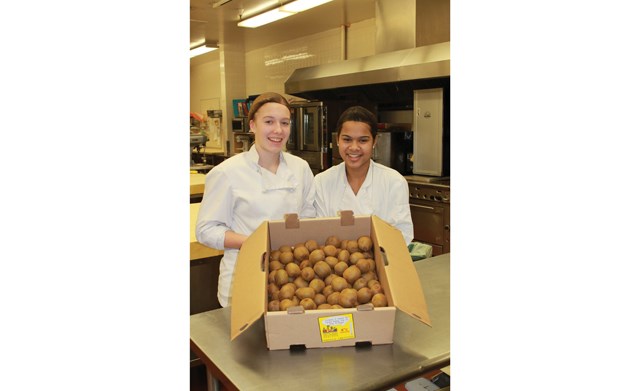Last week, as part of the B.C. School Fruit & Vegetable Nutritional Program (BCSFVNP), Matthew McNair secondary school’s culinary arts kitchen received a delivery of kiwifruit.
Staff and students alike were surprised to discover that this fruit, originally cultivated in China and brought to New Zealand in the 20th century where they were first commercially planted, is also grown right here in B.C.
New Zealanders coined the fruit with the name “Chinese gooseberry” and when it was eventually exported to California, the fuzzy fruit was rebranded with the name “kiwifruit” because of its resemblance to New Zealand’s kiwi bird.
George Petkov, B.C. kiwifruit grower, owns an eight-acre vineyard called Petkov Kiwi Production on the rolling hills of the picturesque Mt. Lehman area of Abbotsford in the Fraser Valley.
The farm is called a vineyard because like grapes, kiwifruit grow on woody vines that are supported by trellises or pergolas.
The area is ideal for this crop because of the clean, fresh air; fertile and nutrient-rich soil; warm summer climate; and moderate winter climate.
Petkov chose to begin growing kiwifruit because this exotic fruit is one of the healthiest fruits on the planet — packed with fibre, vitamin C, vitamin K, folic acid, magnesium, lutein, potassium, and antioxidants that protect against free radicals.
His family liked the idea of growing a fresh, healthy, pesticide-free fruit that could be a popular locally grown option for consumers during the time of year when most fresh fruit is imported.
Kiwifruit do not ripen on the vines, but in cold storage, so they can be kept for up to six months. Therefore, when local availability of most healthy fruit is sparse and costly, Petkov’s supply of kiwifruit is at its peak of freshness and ready for local distribution.
Petkov began his kiwifruit production in 2008 and has been seeing continual increases every year.
In fact, in 2013, he harvested 48 metric tons of kiwifruit and about 75 in 2014, which totals more than 700,000 kiwis. Petkov is still not at full production and estimates that once he reaches that, he should yield between 90 to 100 metric tons. About 10 per cent of of Petkov’s crop goes towards the production of kiwi jam; about five oper cent is sold at the Vancouver Winter Farmers Market; a greater percentage is reserved for wholesale, with IGA being his largest customer; and the bulk of the crop is sold to the B.C. School Fruit & Vegetable Nutritional Program.
In the words of Grade 11 McNair student Josephine Bell, “I had no idea that this exotic fruit is grown in B.C. It’s fantastic that kiwis are grown locally. Thank you for contributing the kiwis to my school.”
Lemon mousse with kiwifruit
Yield: six servings
Ingredients:
5 large eggs
2/3 cup sugar
2/3 cup freshly squeezed lemon juice
3/4 cup whipping cream
6 kiwifruit
Directions:
1. In a medium bowl, whisk together eggs, sugar & lemon juice until blended. Pour into small heavy-bottomed non-reactive saucepan and cook over medium-low heat, stirring constantly with a silicon spatula until thick, about eight minutes.
2. Strain mixture through a sieve into a clean bowl by shaking the mixture gently. Any coagulated egg should be left in the sieve. Place plastic wrap directly on the surface of the mixture and refrigerate until cold, about one hour.
3. In a medium bowl, whip the cream until soft peaks form and fold into the cold lemon mousse. Refrigerate until ready to serve.
4. Just before serving, peel and slice kiwifruit. Divide kiwifruit among the bottoms of six bowls (preferably glass ones, so that you can see the fruit & mousse) and spoon the mousse over the top.
Serve immediately.
Adapted from Emily Luchetti’s lemon mousse recipe. A Passion for Desserts. San Francisco: Chronicle Books, 2003.



